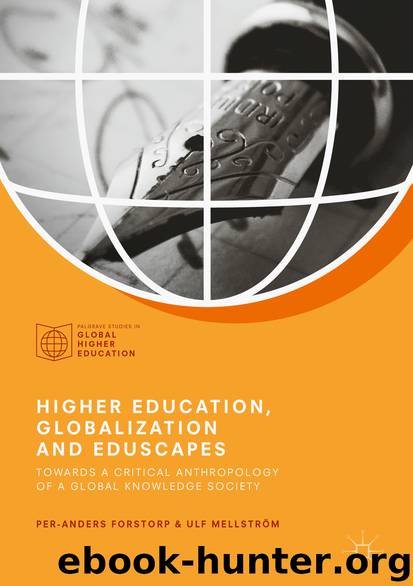Higher Education, Globalization and Eduscapes by Per-Anders Forstorp & Ulf Mellström

Author:Per-Anders Forstorp & Ulf Mellström
Language: eng
Format: epub
Publisher: Palgrave Macmillan UK, London
Competition, the Others, and Social Cohesion
The strategic goal in the Lisbon document emphasizes Europe’s ambition to perform well in comparison with other nations and regions. The goal is to be no more and no less than ‘the most competitive and dynamic knowledge-based economy in the world’ (Lisbon 2000, p. 2). Although the claim seems grand, a certain sense of modesty is involved; being ‘the most competitive and dynamic’ is not the same as wanting to be the best. It is wanting to be the best contender, implying a kind of sportsmanship. It is understood that the competition will be benchmarked through a number of indicators: the knowledge-based economy; sustainable economic growth; more and better jobs; and social cohesion. It is of great concern for the European Council to advocate optimism and the creative potential of Europe. The Lisbon text is a contribution to the ideological cohesion of Europe as a geopolitical entity acting as a regional unit in relation to its member states. Many of the measures exemplified deal with how Europe can use the current regional framework as a context for stimulating internal development through encouraging fair competition between member states. One special method for doing this is ‘the open method for coordination’ (Lisbon 2000, p. 2, 9–10) which is an instrument for guiding, coordinating, and monitoring progress (Gornitzka 2006).
The Lisbon document’s notion of competition can also be applied to the rest of the world, but interestingly enough the rest of the ‘world’ remains vague and unspecified. The name ‘Europe’, the ‘Council’, or the ‘Union’ riddles the text as a reflection of its primary aim to bring about regional consolidation and ideological coordination through a common strategic goal. The ‘world’ is mentioned a couple of times (for instance, in the document’s strategic goal) but without further elaboration. Once, the Union is mentioned in relation to ‘its competitors’, but these others are not specified but could be assumed to be all that are not part of the EU. An effect of this unspecified character of the ‘world’ as the invisible ‘them’ is that everything that is not Europe (‘us’) is a potential competitor (‘them’) and thus simultaneously becomes an instrument for division and image-boosting. The absence of details on the ‘world’ and its conflation with a vague ‘them’ might be explained by the political pedagogy which is characteristic for the document; namely how it works to educate the reader on the ongoing consolidation of the Union and its aim to unite its members through a shared strategic goal for the future. In such a document, one may argue, there would be no place for the ‘world’ nor for globalization (see above).
In a communication from the European Commission that followed the Council meetings in Lisbon (2000), Stockholm (2001), and Barcelona (2002), the role of the universities in these processes of change or ‘quantum shifts’, are centerstage. In the European Commission’s document, a few years later (Role 2003), Europe, the Union, and the Council are still the focus, but the world beyond is now more specified.
Download
This site does not store any files on its server. We only index and link to content provided by other sites. Please contact the content providers to delete copyright contents if any and email us, we'll remove relevant links or contents immediately.
Spare by Prince Harry The Duke of Sussex(4988)
Navigation and Map Reading by K Andrew(4957)
Tuesdays with Morrie by Mitch Albom(4583)
Cracking the GRE Premium Edition with 6 Practice Tests, 2015 (Graduate School Test Preparation) by Princeton Review(4168)
Machine Learning at Scale with H2O by Gregory Keys | David Whiting(3940)
Never by Ken Follett(3697)
Goodbye Paradise(3658)
What It Really Takes to Get Into Ivy League and Other Highly Selective Colleges by Hughes Chuck(3637)
Harry Potter and the Prisoner of Azkaban (Book 3) by J. K. Rowling(3246)
Fairy Tale by Stephen King(3149)
Pledged by Alexandra Robbins(3096)
Kick Ass in College: Highest Rated "How to Study in College" Book | 77 Ninja Study Skills Tips and Career Strategies | Motivational for College Students: A Guerrilla Guide to College Success by Fox Gunnar(3036)
Sapiens and Homo Deus by Yuval Noah Harari(2936)
A Dictionary of Sociology by Unknown(2921)
The Social Psychology of Inequality by Unknown(2893)
Reminders of Him: A Novel by Colleen Hoover(2853)
Graduate Admissions Essays, Fourth Edition: Write Your Way into the Graduate School of Your Choice (Graduate Admissions Essays: Write Your Way Into the) by Asher Donald(2825)
Will by Will Smith(2727)
Zero to Make by David Lang(2678)
